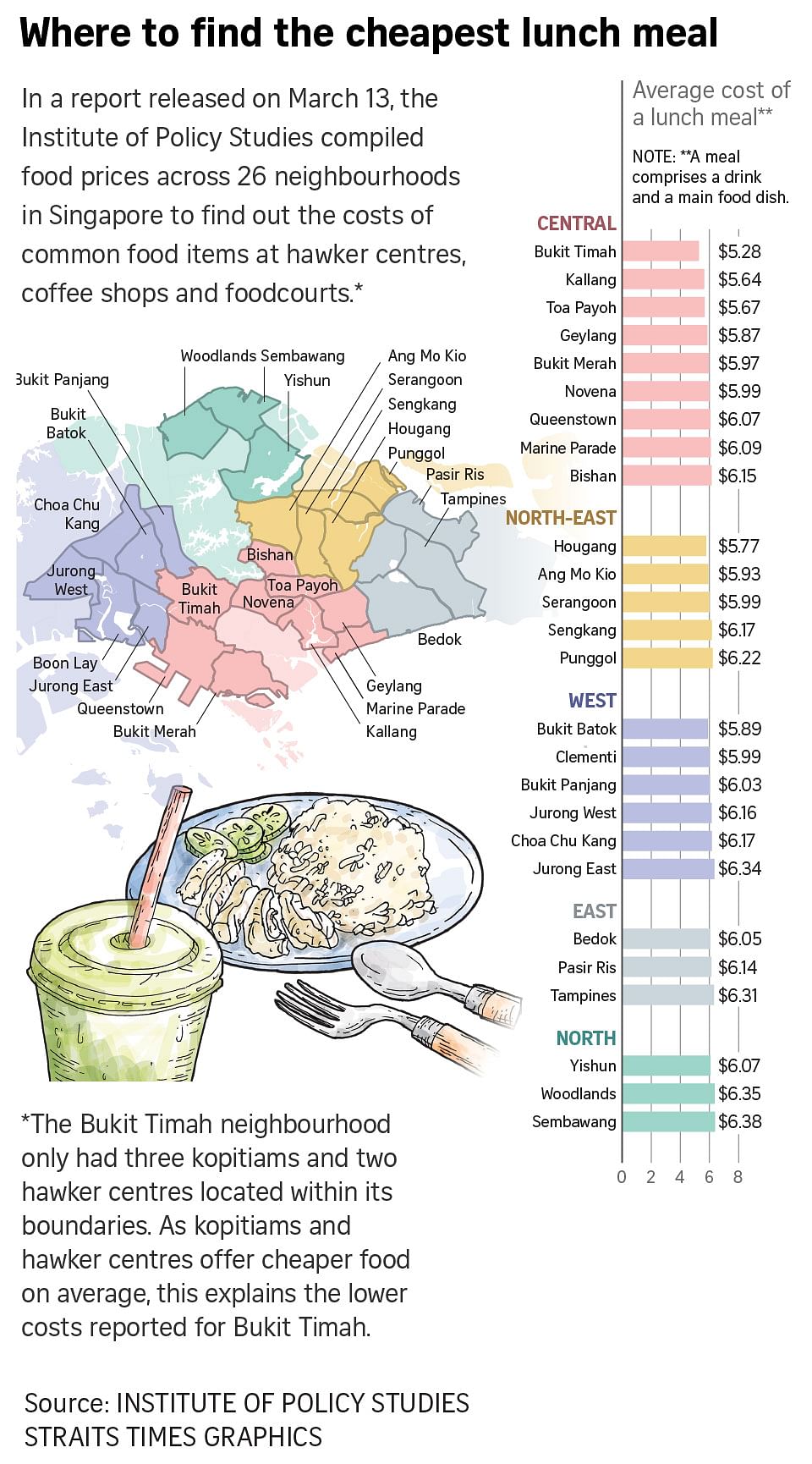Places to find cheapest meals in Singapore, according to Makan Index 2.0


SINGAPORE — The cost of eating out in Singapore is likely to continue to rise relative to individual and household incomes in the future, according to an Institute of Policy Studies (IPS) report on food prices here released on Monday (March 13).
The researchers came to this conclusion after collecting data on the costs of food items and meals at hawker centres, kopitiams and foodcourts from September to November 2022, and January to February 2023.
They found differences in food prices across regions as well as the two time periods, with notable increases in prices for 13 out of 18 food items in the second period.
It is the second time that the IPS is doing a study on food prices here, to come up with what it has called the Makan Index 2.0. The last study was published in 2017.
The team looked at prices of 18 food and drink items or sets commonly sold at the food establishments across the three daily meals, such as kopi-o, wanton noodles, economic beehoon set or chicken chop.
They visited 829 food establishments — 92 hawker centres, 101 foodcourts and 636 kopitiams — across 26 residential neighbourhoods.
The study, led by research fellow Teo Kay Key with research assistants Hanniel Lim and Mindy Chong, is aimed at surveying food prices as a way to better understand an aspect of the costs of living in Singapore. However, it noted that the prices of food items were taken at face value, without adjusting for quantity or quality.
The report pointed out that the five-yearly household expenditure survey by the Department of Statistics found that food constituted 20.3 per cent of a household's average expenditure in 2017 and 2018, the second-largest component after housing and its related expenditure (28.9 per cent).
[[nid:620657]]
The survey also showed that of food spending, just over half was spent at hawker centres, foodcourts and coffee shops as well as similar establishments such as canteens, kiosks and street vendors.
"This is testament to the prevalence of Singapore's unique hawker culture, which has enabled many Singaporeans to eat out at affordable prices. However, living costs, especially that of food, have become a common concern in many parts of the world," said the report.
It noted recent developments such as the Russia-Ukraine war, the mid-2022 ban on chicken exports from Malaysia to Singapore, and the increase in goods and services tax here that have impacted food prices.
Comparing the data collected over the two time periods, the researchers found that most stall owners did not increase their prices, while a majority of those who did did so by only a small margin.
The researchers noted that due to manpower and time constraints, they did not revisit all the establishments from the first round of data collection and returned to only 50 of the 829 original sites.
The average increases in prices at these revisited stalls did not exceed 30 cents, and did not go above 10 cents for most food items, they found.
Comparing prices across regions in their overall data, the researchers found differences for nine out of 18 of the food and drinks surveyed.
Drinks and chicken chop were found to be cheaper in the central region. The breakfast set — comprising kaya toast, two soft-boiled eggs and coffee or tea — and fishball noodles were found to be cheapest in the north, while prata was found to be cheaper in the west.
In terms of food and drink items, kopi-o was the cheapest drink on average at $1.09 while iced Milo was the most expensive at $1.81.
Two pratas — one plain and one egg — were the cheapest at $2.97 on average, while chicken chop was the most expensive at $7.58.
Foodcourts generally had the highest prices, followed by kopitiams and then hawker centres.

The report found that food items that did not follow this trend were the breakfast set — cheapest in hawker centres, while costing the same in kopitiams and foodcourts; the vegetarian beehoon set — cheapest in hawker centres, followed by foodcourts and then kopitiams; as well as chicken rice and economic rice — cheapest in kopitiams, followed by hawker centres and then foodcourts.
Looking at meals — comprising a drink and a main food dish — on average, breakfast was the cheapest meal at $4.81, followed by lunch at $6.01 and then dinner at $6.20.
The total average cost of three meals a day in hawker centres, foodcourts and kopitiams was $16.89, said the report.
Based on this figure, the average cost of eating out for a month of 30 days is $506.70. Meal costs on average did not vary significantly across regions.
Here are some of the other numbers:
[[nid:620519]]
The report found that overall, while some dishes like economic rice and fishball noodles remain relatively affordable, costing under $4 on average, other common dishes like chicken rice and wanton noodles exhibit a much larger price range.
The team attributed this to some degree to an increasing number of stalls that are no longer selling traditional offerings, or which sell commonly found dishes like chicken rice with a pricier twist, indicating dynamism and innovation in local food culture.
The study concluded that the cost of eating out in Singapore is likely to continue to rise relative to individual and household incomes in the future.
It said: "The hope is that real wages will increase at similar rates; if not, individuals and households will face higher food costs.
"While hawker culture in Singapore is an essential and convenient source of hot, delicious meals for Singaporeans, it may no longer be able to remain as cheap relative to other meal options, given the changes in the economic environment."
ALSO READ: Hawker accuses diners of 'screaming' and shaming his staff over request for extra bowls
This article was first published in The Straits Times. Permission required for reproduction.